
Welcome back to The Node Ahead, a cryptocurrency and digital asset resource for financial advisors. Every other week, we discuss the latest crypto news and the potential impacts it may have on you and your clients.
In this edition, we’ll review:
- More banks roll out crypto services
- The number of crypto developers continues to grow
- Crypto adoption by geography
- Ethereum post-merge
Before we jump into this week’s headlines, we wanted to highlight the latest edition of Bloomberg Businessweek, which dedicated the entire issue to a single article on crypto. It’s a rather introductory piece aimed at those who know more about business than crypto, covering everything from the basic principles and technology of digital assets to the most fascinating social implications. This article matters, not because of what’s in it (though it’s generally positive) but rather because of who it is coming from. Bloomberg is one of, if not the, most influential and respected mainstream business news outlets, and its author, Matt Levine, is arguably the most respected financial writer at any publication. Levine, who comes from Goldman Sachs, brings mainstream, blue-chip credibility and a very approachable writing style that allows for non-experts to grasp the complex topics he covers. Having Matt Levine explain why Bitcoin and crypto matter in detail, and in a manner that many are likely to understand, could influence an entirely new wave of finance professionals to take it seriously. Finally, the fact that Bloomberg is dedicating an entire issue to only one topic, something they have only ever done once before, is a clear signal to the business world of the importance of this emerging industry.
Banking on the future
In what’s becoming a recurring segment in this newsletter, more traditional financial players are jumping into the crypto market. Let’s start with BNY Mellon, where executives from the company recently discussed why they decided to add a crypto custody solution. According to BNY, 75% of their clients are either investing or actively considering investing in digital assets, and 90% of clients expect to be investing in digital assets in the next few years. This is coming from executives at the world’s largest custodial bank, whose clients own an aggregate of $42.2 trillion. These comments mirror similar findings recently put out by Fidelity, who reported that 81% of institutional investors believe digital assets have a role in a portfolio.
That same day, France’s third largest bank announced it is now offering cryptoasset custody and trading services. The move by Societe Generale, which has over $1.6 trillion in assets and is among the largest banks in Europe, is yet another example of the growing appetite by mainstream financial institutions to offer crypto-related services to their clients.
And finally, Mastercard is looking to get in on the adoption as well by launching a new service called Crypto Source which will make it easier for banks to offer cryptocurrency trading to their clients. This isn’t Mastercard’s first foray into crypto, as the credit card company has already teamed up with Coinbase on NFTs and Bakkt to let banks and merchants in its network offer crypto-related services. Not to be outdone, Visa recently partnered with FTX to offer crypto debit cards in 40 countries, and American Express has partnered with Abra to offer crypto rewards.
Customer demand is growing and as a result banks not only see crypto related services as a necessary offering they must have to remain competitive, but also as a new business line in which they can make money. All that will do is increase the ease of access and adoption for the mass market. In the coming years expect to see more and more consumers earning yield from stablecoins, using bitcoin as collateral for loans, and holding various digital assets alongside traditional savings accounts.
Developer count grows
If the number of traditional financial players coming into the space doesn’t give you confidence about the long-term prospects of this industry, maybe the amount of talent coming in will. A leading indicator for any tech platform, not just crypto, is growth in the number of software developers focused on the technology. This is because developers build the applications that deliver value to end users and customers. In turn, this attracts new users, and the more users a platform has, the more attractive it is for developers to build on, thus creating a cycle of growth and adoption. Because the crypto stack is uniquely open source, we can analyze and understand developer engagement in an unprecedented way.
At the start of the year, we highlighted how engineering talent migrated to the crypto industry in record numbers in 2021. But that was during a bull market, when the prospects of making money were at an all-time high. How has developer growth changed over the past 10 months, given that prices fell substantially and we’re now in a bear market? The answer may surprise you.
According to a recent report of on-chain and GitHub data, the number of developers in the crypto space is bigger than ever. Even though the market cap of digital assets has dropped 58% in 2022, the number of smart contracts, blockchain decentralized apps (dApps), and software developer packages being deployed have all gone up. Ethereum developer activity surged 40% to all-time highs despite ETH being down 64% year to date. It’s not just Ethereum, either—we now have more than 12,000 dApps and counting. Solana, Polygon, Optimism, Arbitrum, Chainlink, and many more all saw record developer growth in Q3. In fact, Q3 was arguably the biggest month in crypto’s history in terms of developer engagement.
The fact that the builders within the crypto industry aren’t running for the hills during one of the largest bear markets in crypto’s history and are instead doubling down is further evidence of the industry’s long-term health. Sometimes, it’s as simple as just following the talent, and right now, many of the most talented engineers are flocking to the crypto industry.
Worldwide crypto adoption by geography
Though our financial system is far from perfect in the U.S., it typically works well enough for most citizens. The dollar is relatively stable, the vast majority of US citizens have bank accounts, and payments generally get processed without much hassle for the end user (though it does usually take days to settle and costs the vendor roughly 2-3%). However, in many other geographies around the world, this simply isn’t the case. For a large portion of the world, crypto offers a better form of saving, a better means of transacting, and better access to financial services than the existing system. Because we in the US often take our financial system for granted, many view crypto’s only use case as speculation, but for much of the world, crypto is providing tangible life improving benefits. And we have the data to support these claims.
Because every transaction is recorded on the blockchain, it’s possible to both track and interpret the flow of assets. It’s the same reason why law enforcement would always prefer criminals to commit illicit acts using cryptocurrencies rather than cash. But we can use this same detailed analysis of on-chain flows for more than just capturing criminals. Every year, blockchain forensics company Chainalysis puts out a report on the adoption and use of digital assets by various geographies around the world based on on-chain data.
Of the top 20 countries with the highest crypto adoption, only 2 are high-income countries (United States and United Kingdom) according to standards set by the World Bank. The users in lower income countries are relying on digital assets and services to “send remittances, preserve their savings in times of fiat currency volatility, and fulfill other financial needs unique to their economies. These countries also tend to lean on bitcoin and stablecoins more than other countries.” According to the report, crypto transactions in Latin America are up 40% from last year as people in regions such as Venezuela and Argentina use crypto to save and send payments. Due to hyperinflation in Argentina and the government’s strict capital controls, an increasing number of people are turning to stablecoins for retail transactions.
In the Middle East and North Africa, fluctuating cryptocurrency prices have coincided with rapid fiat currency devaluations, strengthening the appeal of crypto as a way to preserve savings. The best example of this would be in Egypt, where remittance payments account for about 8% of the country’s GDP, and the country’s national bank has already begun a project to build a crypto-based remittance solution. Combined with increased currency inflation, it’s easy to understand why the country saw 221.7% year over year growth in crypto transaction volume.
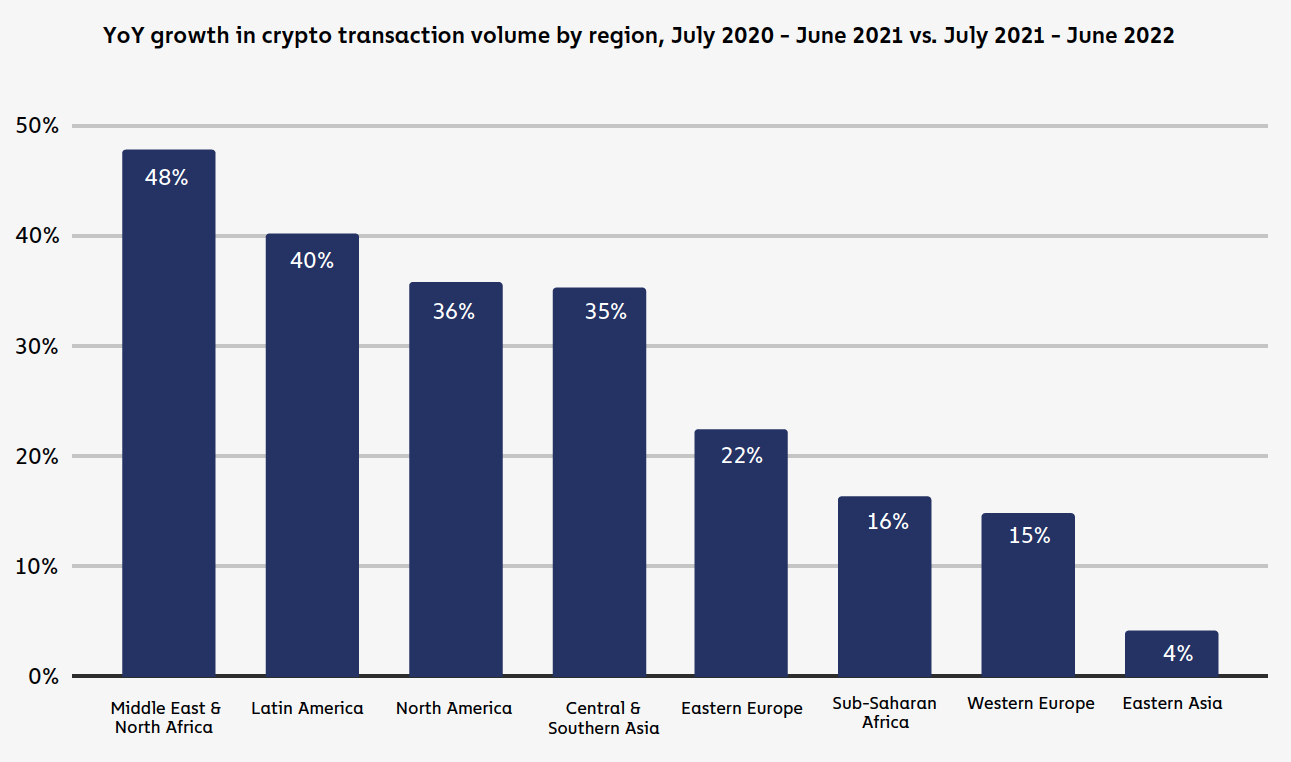
Source: Chainalysis, “The 2022 Geography of Cryptocurrency Report”
The overarching takeaway is that crypto penetration tends to be highest in emerging markets where its benefits are most tangible. The places that have strict capital controls, high inflation, or financial and government corruption are the same geographies in which a greater number of people are turning to crypto as an alternative. The fact that crypto adoption isn’t highest in developed markets speaks to the usefulness of the industry beyond a merely speculative investment.
Checking in on Ethereum post merge
On September 15th, Ethereum successfully changed its consensus mechanism from proof of work to proof of stake (we covered the Merge in detail in our August 23rd issue if you would like a refresher). It’s now been a little over a month since the Merge took place, so we thought it would be a good idea to take a look at what is happening on the Ethereum blockchain.
Leading up to and following the Merge, the growth rate of new validators on the network (those responsible for validating transactions) noticeably increased. Ethereum currently has over 451,000 active validators on the network, 33,000 of which have come online since the start of September. This is likely due to technical risks of the Merge being alleviated and more investors looking to profit by staking Ether.
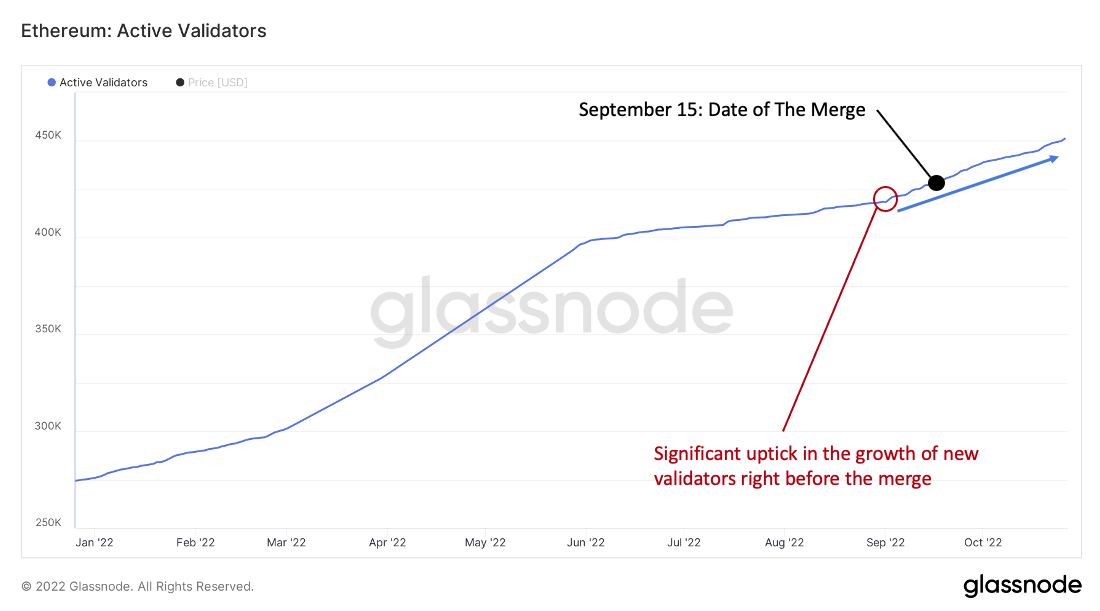
We can test this theory by looking at the growth of staked ETH. Remember, a proof of stake system is operated by validators who deposit digital assets (ie “staking”). Once a participant validates the latest block of transactions, other nodes on the network confirm (aka attest) the block is valid. When enough attestations are made, the network adds a new block, and the validator receives a transaction fee as a reward. Currently, 14.5 million ETH have been staked, which represents 12.1% of the total supply. That is up from 2% of total supply at the start of the year.
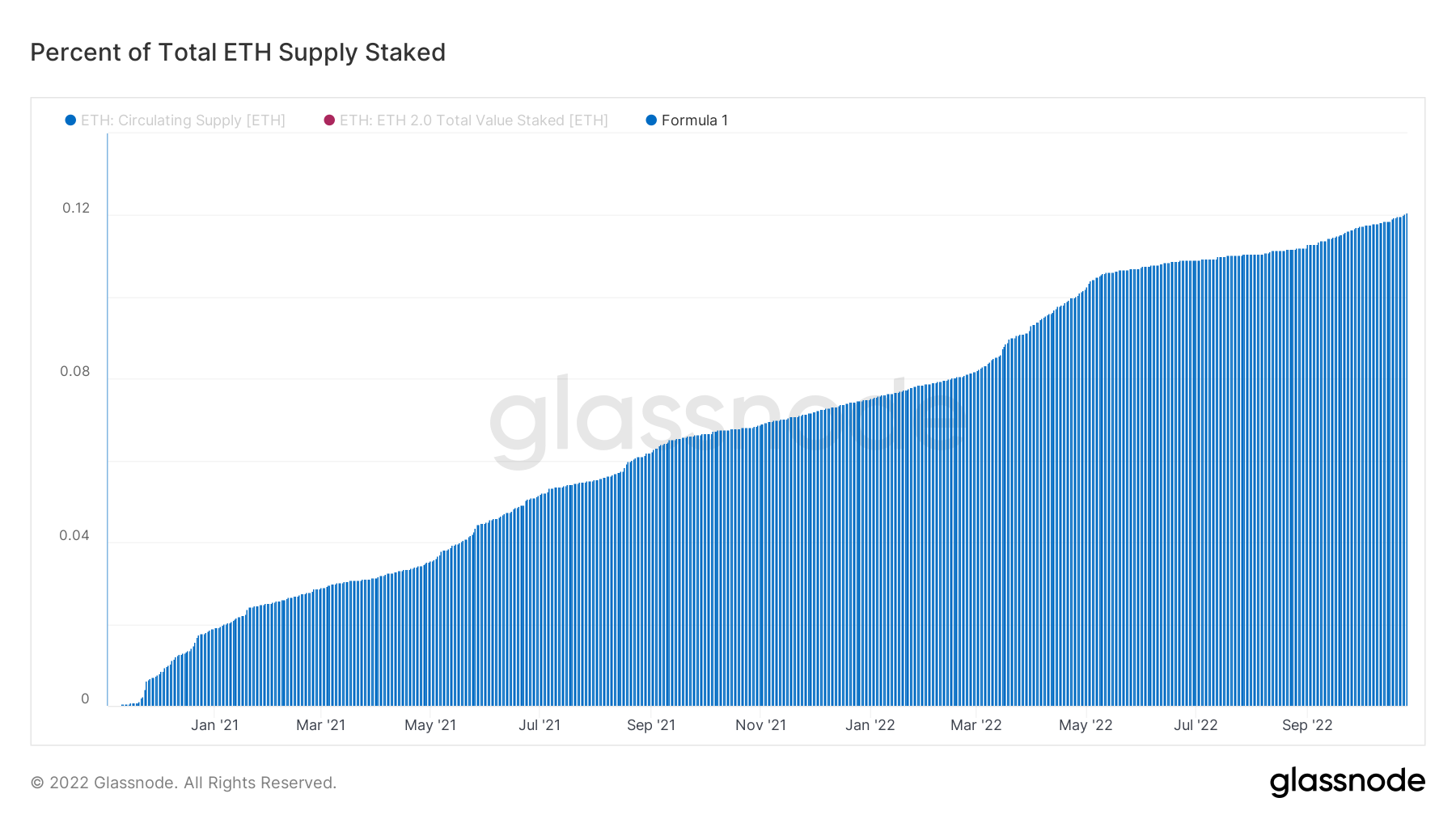
However, one risk we noted in our previous newsletter is the potential for regulatory capture. Although Ethereum is decentralized, staking providers are not. Though it’s possible to stake ETH on your own and in a fully decentralized way, there are high capital and technical barriers to doing so. Thus, most people opt to stake through a third-party service. These entities are subject to regulatory whims just like any other company, and should too much ETH be staked in these centralized entities, it opens the Ethereum network up to regulatory and censorship risk.
A majority of the 14.5 million Staked ETH is hosted by a variety of staking service providers, accounting for over 10.4 million ETH (72% of the total staked supply) and growing. The top 5 service providers (Lido, Coinbase, Kraken, Binance, and Staked.US) manage a combined 61% of all staked ETH, with Lido accounting for 30% alone. This will be a key metric to keep an eye on in the coming years.
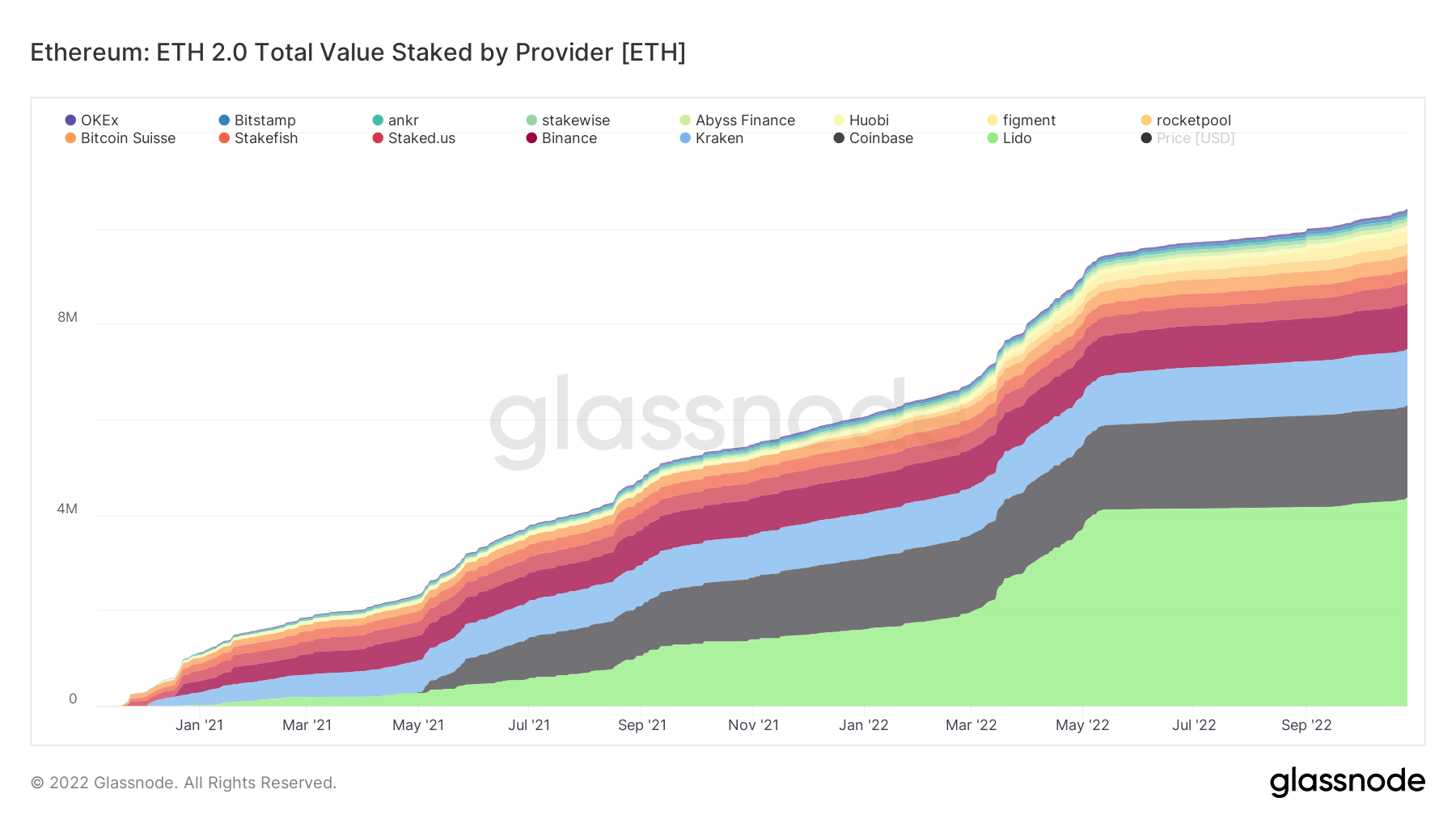
This is a well-known risk throughout the Ethereum community, and Ethereum developers are already working on a solution known as proposer-builder separation (PBS). As its name suggests, PBS splits the validator role into two separate roles; Proposers and Block Builders. Without getting too into the technical weeds, this should result in maximizing validator decentralization. However, PBS is technically complex, and likely won’t be ready to go live for several years.
Many also predicted that the Merge could be a potential economic catalyst for the underlying token, ETH. By switching to a POS model, the annual issuance of new ETH was expected to drop dramatically. When taken in combination with the fee-burning mechanism implemented last year (EIP 1559), it was theorized that the Merge could lead to more ETH being destroyed than created per day, turning ETH into a deflationary asset.
The Merge to proof of stake did drastically reduce the issuance of new supply, as was intended. However, with activity volumes being down due to bear market conditions since the Merge, ETH burn hasn’t been high enough to turn ETH deflationary yet. Today, the amount of newly issued ETH per day is still greater than the amount burned per day.
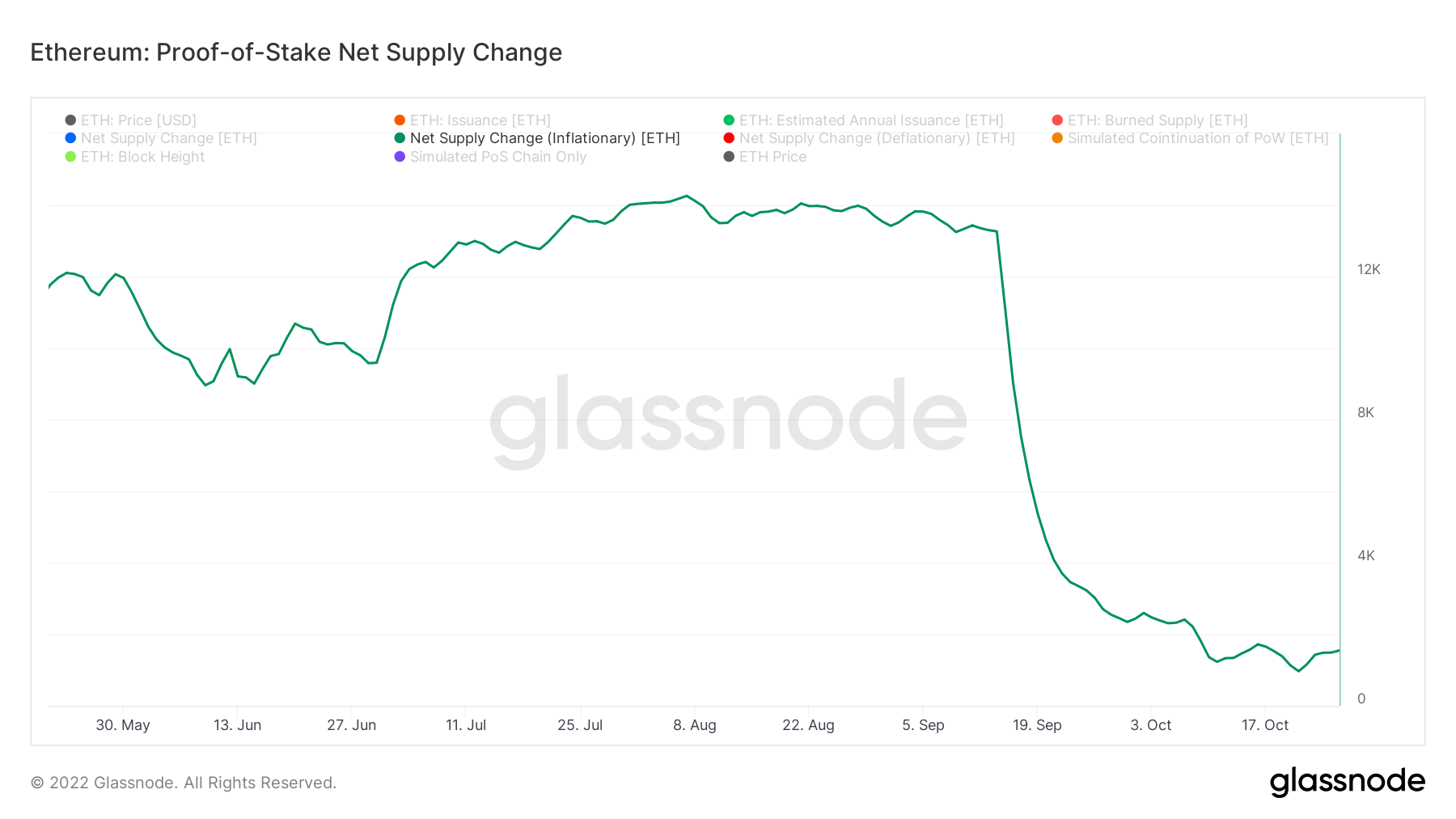
We will continue to monitor the on-chain data in the Ethereum ecosystem, just as we do for many digital assets. The beauty of the crypto industry is that it’s such a data rich environment, and far more transparent than the traditional financial system. Because of that, we can tell very quickly and very accurately if changes to protocols have their desired impact.
As always, the on-chain data is provided by Glassnode. If you would like to have access to the data yourself, you can sign up here.
Conclusion
As we often stress time and again in this newsletter, price is a poor indicator for the growth and development of the crypto industry. Despite the steep drawdowns of this year, an increasing number of banks are releasing crypto services, developers are still flocking to this industry, and real world use (not just financial speculation) throughout the world is increasing. All the signs you would want to see during a bear market that set the stage for the next bull market are there, you just have to look beyond the price chart.
In Other News
The SEC and CFTC are examining whether crypto hedge fund Three Arrows Capital violated rules by misleading investors about its investment strategy.
France may change its cryptocurrency laws next year as the country aims to become a leader in blockchain technology.
The highly anticipated launch of Aptos was, at best, underwhelming as tokenomics and transaction speeds are nowhere near as expected.
The Blockchain Association has filed to submit a brief in Grayscale’s appeal for its bitcoin ETF application stating that the SEC’s approval of a futures-based bitcoin ETF but not a spot product constitutes an uneven treatment.
New tax guidelines from the IRS mean that NFT holdings fall under the same tax regime as cryptocurrencies and stablecoins.
Ripple Labs has obtained email records from former SEC director William Hinman which are likely to provide significant insight into his thought process and that of his colleagues at the SEC regarding whether certain digital assets should be treated as securities or not.
Cash App users can now send and receive bitcoin via the Lightning Network.
The United Kingdom votes to recognize bitcoin as a financial instrument.
CFTC Chair Rostin Behnam said he considers Ether a commodity, not a security.
Disclaimer: This is not investment advice. The content is for informational purposes only, you should not construe any such information or other material as legal, tax, investment, financial, or other advice. Nothing contained constitutes a solicitation, recommendation, endorsement, or offer to buy or sell any securities or other financial instruments in this or in any other jurisdiction in which such solicitation or offer would be unlawful under the securities laws of such jurisdiction. All Content is information of a general nature and does not address the circumstances of any particular individual or entity. Opinions expressed are solely my own and do not express the views or opinions of Blockforce Capital or Onramp Invest.
